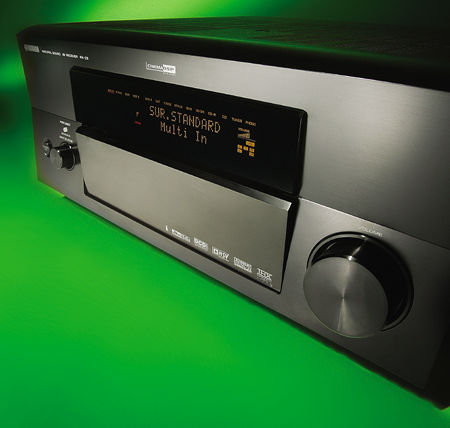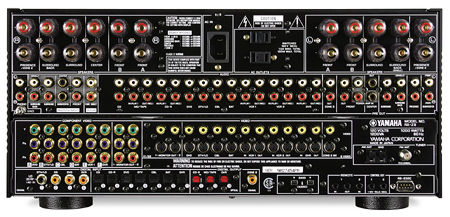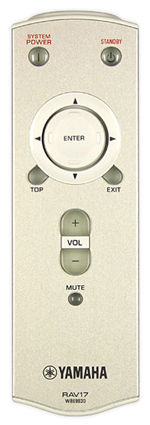Yamaha RX-Z9 AV receiver

Yamaha's So Phat
The coolest thing about the RX-Z9 is its built-in, automated audio-calibration routine, which can accurately determine speaker distance, level, and required equalization for flat frequency response in your room. The RX-Z9 offers 5 individual EQ Selections (Flat, Front, Low, Mid, and High), plus a "Skip" feature. I placed the long-corded measurement microphone (in-cluded), which is mounted on a small, weighted, circular base 2 inches in diameter, atop the seatback cushion of my listening chair (essentially at ear level) and initiated the test-signal sequence. With built-in test tones of the burst and noise variety and more brains than your average reviewer, I gave the Yamaha the reins, at least the first time around.
When I reviewed the results, it turned out that the Yamaha had mistakenly determined that the Paradigm Signature S4 speakers in the rear of the room were of the Large variety, while the identical ones in the front of the room responded as if they were Small. According to Yamaha, the loudspeaker position and room characteristics can cause the system to alter some of the initial settings. Fortunately, you can run through the procedure in a stepped fashion, skipping those steps in which wrong conclusions are drawn. After manually setting all the speakers to Small and reducing the 90Hz crossover to 80Hz to be compliant with THX, that's exactly what I did.
Most of the setup can be done from the best seat in the house, using the RX-Z9's remote control to follow the onscreen menus. The menu system itself is too clever by half, making it likely that novices and experts alike will occasionally lose their bearings. Menu hierarchies are explored from left to right, while options at each level are listed vertically.
This is fine in concept, but the implementation is slightly off the mark. For one thing, some menus can be four or five levels deep, but the Yamaha displays only the layer you're on and the one directly under and to the right of it. For another, each level can display only five entries before it starts to scroll vertically. Given the huge amount of blank space that Yamaha provides around each option, perhaps so as to make the task appear not too daunting, users will need some time to get used to this. Once that happens, Yamaha can justly claim credit for a novel and, overall, solid approach to processor setup.

Yamaha provides two remotes with which you can gain that required familiarity. The graphic user interface (GUI) model is a small, minimalist affair that can be used to operate the RX-Z9 whenever you're watching TV, assuming your video passes through the receiver; happily, the onscreen display also appears through the component output. Besides providing access to the Volume and Mute functions, the GUI remote is otherwise adorned only with Power buttons and four cursor controls with an Enter button at the center.
The main remote, a massive black affair with more buttons than a seamstress, is reasonably well laid out. Finger memorization was quick despite the fact that the small buttons are tightly grouped, and the precious few that are backlit—the menu navigation controls—are more intuitively presented on the GUI remote.
The RX-Z9's room-equalization circuitry is a good stab at a valuable concept. The results of the auto EQ calibration can be viewed on a relatively tiny line graph that lacks calibrations for decibels and hertz. The larger bar graph used for manually setting level across the nine bands is much more useful, and could have provided a clearer picture of the system's room measurements.
When you manually set EQ, each speaker is individually addressable. The maximum 6dB of boost or attenuation available for each band is relatively mild and designed to keep users out of trouble. Had Yamaha allowed the results obtained from the automated EQ process to serve as the starting point for the manual EQ, the system and room response would have been easier to understand and tweak.
With only nine separate frequencies, and only three of them (63Hz, 125Hz, and 250Hz) in the (very liberally defined) bass region, it initially appears that the Yamaha can cure only gross room anomalies. Then again, given the dearth of bass frequencies within its control, it's perhaps not surprising that the EQ has no effect on the subwoofer channel, much of whose content lies below the receiver's lowest addressable frequency. This is unfortunate—bass is one area where equalization stands to provide the greatest benefit with the least overall detriment, as witnessed by the rash of high-end subwoofers that offer parametric EQ to deal with a room's worst frequency node(s).
The RX-Z9's manual indicates that, on dynamic peaks, the 170Wpc into 8ohms power rating can double when sent into 4ohms, producing an impressive 340W—albeit with no specification of the number of channels simultaneously driven. The receiver will even deliver a usable peak output of 540W into 2ohms—but for how long, only your hairdresser knows for sure. Yamaha takes protective measures to ensure that the RX-Z9 is comfortable with lower-impedance loads, offering a way to configure the amplifier for use with 6ohms loads (through a power-up procedure, not the onscreen menus).
I can vouch for the fact that, without resorting to the 6ohms setting, the Yamaha very comfortably drove the 4ohms loads of the notoriously insensitive Magnepan 3.6, 1.6, and CC3 speakers to very high levels. A word of caution: the rear panels of receivers like the RX-Z9 are always squeezed for space, and this one's speaker terminals are practically on top of each other. Forget about spade lugs—here, it's strictly bare wire and bananas plugs.
 When it comes to counting channels in their high-end receivers, Yamaha plays a numbers game. When everyone else was promoting 5.1-channel receivers, Yamaha upstaged them with 7.1 channels. Now that 7.1 is all the rage—you guessed it, Yamaha goes to 9.1, with the extra two speakers to be positioned in front, high on the walls and spread slightly farther apart than the main speakers.
When it comes to counting channels in their high-end receivers, Yamaha plays a numbers game. When everyone else was promoting 5.1-channel receivers, Yamaha upstaged them with 7.1 channels. Now that 7.1 is all the rage—you guessed it, Yamaha goes to 9.1, with the extra two speakers to be positioned in front, high on the walls and spread slightly farther apart than the main speakers.
Yamaha has always been ahead of the curve. In the mid-1980s, Yamaha engineers traveled the world, scrupulously measuring famous concert halls, then mathematically programming the results into a new line of digital sound processing (DSP) equipment in an attempt to re-create those venues in the listening room. Their first such model, the DSP-1 surround processor, found its way into my fledgling home theater in the late '80s, when I experimented with blending two extra "effects" channels into the front main speakers. The number of channels may be Yamaha's obsession, but mine is practicality, and I've always run a 5.1 system in my home theater. At this point, Yamaha could fairly judge me as being an entire Quadraphonic system behind the times.
The RX-Z9 is definitely the receiver for the person who has been seduced by this hobby for a long time and wants to keep reaping the rewards of years of accumulated musical and visual wealth. Let's start with laserdisc collectors. One of the RX-Z9's four coaxial digital audio inputs can be configured to demodulate RF datastreams from AC3-encoded laserdiscs, thus giving you Dolby Digital 5.1—something for which, a decade ago, LD collectors paid dearly ($40–$50 per movie!).
Another charming, anachronistic touch that brought joy to my ears was the inclusion of a phono input for moving-magnet or high-output moving-coil cartridges, as well as a Direct Analog mode—your cherished LPs will be gently accompanied on their journey without ever visiting the digital dark side. And if you have a great 2-channel preamp that works such magic on your vinyl or CD collection that you can't bear to part with it? Yamaha provides front-channel Preamp In inputs: You can hook up your gifted 2-channel preamp directly to the RX-Z9's powerful power-amp stage, bypassing the receiver's volume controls and everything else.
As a flagship consumer product from a company whose musical-instrument division has forced it to learn more about digital than perhaps any other company in the world, the Yamaha RX-Z9 should be expected to offer the latest in current technological thinking, and even dip into some speculative musings on the future of audio. It does. For instance, instead of a 6-channel analog input for SACD and DVD-Audio discs, Yamaha offers an 8-channel input (those two extra channels again!). If you have an iLink-equipped (aka IEEE1394 or FireWire) multichannel player, you should be able to keep the audio signal in the digital domain from player to processor (although not all such players are compatible with all such receivers). And, of course, Yamaha provides their seemingly endless parade of DSP-created "rooms." This time there are 21 different concert halls, churches, and jazz clubs, many of them distinctly identified, such as Manhattan's Bottom Line jazz club, and all of them are modifiable. I had my fill of these modes in about two minutes, but don't let me stop you.





























































